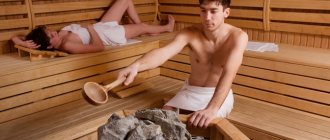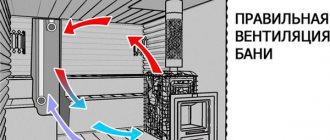Prevention work at the stage of laying and building a bathhouse
The most effective protection against fungus is carried out at the design and construction stage. Recommendations for preventing mold growth:
- It is important to use wood cut in winter. It is recommended to lay the foundation in frosty weather, and build the walls and roof in the spring.
- Before starting work, it is necessary to study the wood. If there are traces of fungus on at least one of the logs, it is better to set aside the entire batch and replace it with a new one . There is a special device that allows you to measure humidity levels. It helps select dry wood for construction.
- When designing or drawing up a drawing, it is important to think through and note the location of the holes for natural ventilation. They should be under the floors in the crawl space, in the attic, in the ribs of the frame.
- Before erecting walls, it is necessary to consider waterproofing the foundation. It is recommended to protect all supporting structures with a vapor barrier.
- You should not save on buying a powerful hood or antiseptics.
- Freezing walls, slopes, and ceilings need to be insulated and ventilation valves installed in plastic windows.
What can you do if a fungus appears in a bathhouse during its operation?
Recommendations for preventing the emergence of new lesions:
- It is necessary to eliminate leaks in plumbing and pipes.
- It is necessary to check the sources of forced and natural ventilation.
- If the bathhouse is heated constantly, you must always maintain a high temperature inside.
- After turning off the heating, it is necessary to remove wet rags outside: towels, rugs that lie on the floor, benches. Screens and textiles must be carefully straightened so that they dry.
- The fungus actively reproduces on dirty surfaces, so the interior must be washed after each visit with water using products intended for the hygiene of baths and saunas.
Removal methods
The fungus develops very quickly, but it is difficult to destroy. You need to get rid of it in every possible way until you achieve the desired result.
How to remove fungus in a bathhouse?
Modern industrial means are used to remove mold, but you can also use traditional methods.
Bleach
Bleach can kill any type of fungus. This product is only effective if mold is growing on non-porous materials such as tiles, glass and countertops.
When using Whiteness on these surfaces, you should know that the fungus will still remain inside and after a while the problem of removing the spores will arise again.
When using this composition, protect your hands with gloves and your respiratory tract with a special mask.
How to get rid of fungus:
- To remove spores, Whiteness is diluted with water. For 1 liter of bleach there are 10 parts of water. For saunas, the solution can be made more concentrated.
- The resulting composition is applied to non-porous materials using a sprayer or sponge.
There is no need to wash anything after this. Leave doors and windows closed for a while. Then open and ventilate the room.
Borax
Borax can also fight mold. This is a natural product that does not release chemicals and toxic substances that are hazardous to health.
Borax is a white mineral powder with low toxicity, sold in pharmacies.
This substance is commonly used as a deodorizer for toilets and drain cleaning. Borax is also used as an insecticide, herbicide and fungicide and to remove mold in the sauna.
This sauna product has many advantages.
How to remove fungus in a bathhouse:
- Dilute 1 cup of borax in 2.5 liters of water.
- Treat the steam room on all surfaces, including the floor and ceiling. Mold multiplies quickly and it is unknown how quickly and where the spores have spread.
- After a few hours, wearing gloves and a respirator, take a rag and wipe off any moisture that has appeared. Go over the walls, ceiling and floor with a clean, dry cloth. This will prevent spores from spreading into the air after the treated areas dry.
- Then re-treat the walls. There is no need to wipe them a second time. Leave the bath alone until completely dry.
The fungal colony will not be destroyed the first time. To achieve maximum results, the procedure using borax will have to be carried out several times, and maybe more.
The number of such treatments is unlimited. Focus on the effect obtained and choose for yourself whether it is worth smearing the walls again or the fight against the fungus is over.
Vinegar
Vinegar is considered a weak acid. It will remove mold in the bathhouse, however, after a while it may appear again.
Acetic acid can kill 82% of fungal species.
How to get rid of mold in a bathhouse:
- To remove spores in the sauna, it is recommended to use distilled white vinegar. It is cheap and sold in grocery stores. It is better to use vinegar in its pure form, without diluting it with water.
- Unscrew the cap and put on the sprayer.
- Spray vinegar on the moldy surface and leave the room for 1 hour.
- The infected area does not need to be rinsed with water after this treatment. After 1 hour, repeat the procedure.
The smell of vinegar will dissipate within a few hours. Leave the sauna doors and windows open.
To enhance the effect, you can treat the surfaces with chemicals containing ammonia. Follow the instructions on the label and remember to wear gloves.
The procedure should be repeated every two days for a week to get rid of the spores permanently. You can treat wooden surfaces, tiles and other places where mold has appeared with vinegar.
Ammonia
An aqueous solution of ammonium hydroxide will kill fungal spores on non-porous surfaces. In the sauna, it can be used to remove mold on tiles, taps and pipes. Ammonia is useless for wood.
The disadvantage of using ammonia is its toxicity. Ammonia should never be mixed with White, because the gas that begins to be released is too toxic and harmful to health.
How to fight mold with an aqueous solution of ammonium hydroxide:
- Combine ammonia and water in a 1:1 ratio.
- Pour the mixture into a spray bottle.
- Treat all surfaces of the sauna in each room without missing a single area, because it is unknown where the mold has managed to reach. It is necessary to spray the solution even on clean places; it will not be superfluous if there is no fungus there - it will be prevention, which is also good for such rooms as baths, saunas and baths.
- After 2–3 hours, the treated surfaces must be rinsed with water and the room left to be ventilated.
Ammonia solution is a good disinfectant. Use this method to remove mold from your bathhouse several times a month.
How to deal with a fungal colony
Mold most often appears in wooden baths, which are heated not constantly, but from time to time. Fungal colonies have no special preferences. They settle on walls, floors, ceilings, where there is the most dampness . If the room is not insulated enough, a white mushroom appears on the tree (see photo).
You can fight a fungal colony:
- mechanically,
- chemicals,
- folk remedies.
Mechanical way of fighting
The method involves manually rubbing the affected area using a spatula, iron brush, or sandpaper. You can use a grinder or drill equipped with a brush attachment.
When performing mechanical cleaning, you need to look at how deep the fungus has penetrated into the soft texture. You can make a replacement. To do this, you need to cut out the affected area in the timber and insert a new fragment in its place.
Before cleaning the boards, the base must be thoroughly watered. Humidity will prevent the spread of pests.
How to remove mold in a bathhouse
So, the enemy has been discovered, now it is important to begin the fight against him, which can be waged using the following means:
Chlorine-containing substances
They will help to cope perfectly with the disinfection of the room. By treating the bathhouse coating with these products, we get rid of not only fungus, but also a host of other harmful bacteria. Some products can not only remove fungus, but also whiten wood by several shades.
Products such as Senezh and Frost have proven their effectiveness. They need to treat the entire internal surface of the bathhouse; sometimes, to completely disappear the enemy, you have to repeat the treatment twice or three times.
Sulfur
Another method involves the use of sulfur fumes. You need to act this way:
- remove the flow of air into the room, carefully closing all cracks and openings for ventilation;
- now, taking up to 200 grams of sulfur per 100 cubic meters of room, you need to set it on fire, placing it in a metal container;
Sulfur combustion products have a detrimental effect not only on the fungus, but also on the human body, so you need to leave the room immediately.
You can enter the bathhouse only after 9 hours, after which you need to place a container with quicklime, which has the ability to absorb excess sulfur dioxide.
Chlorine-based lime
- Having put on protection in the form of a respirator and gloves, you need to clean the walls from mold with a brush;
- Having dissolved quicklime and bleached lime in water, apply this composition to the walls;
- Now you need to leave it for some time to take effect.
inkstone
You can apply a composition to the walls that includes iron sulfate (25 g), table salt (20 g) and potassium alum (45 g), as well as a liter of water. This mixture is capable of removing all traces of mold, however, it is important to re-treat after a month.
Mechanical mold cleaning
Mechanical methods also give good results, which can help in removing fungus from the walls of the room. For this purpose, you can use the following tools that allow you to carry out both manual and automated influences:
- putty knife;
- sandpaper;
- drill with a brush attachment;
- Grinder;
- brush with iron teeth.
When cleaning wood in this way, you should pay close attention to the depth of penetration of the fungus; if it goes inside the board, there is a need to completely replace the affected element. Separately, it should be noted the need to moisten the surface before cleaning so that dry fungal spores do not spread through the air in the room.
Antifungal agents
In addition, fungus can be removed using specialized products that can be found on the shelves of hardware stores. The following substances have proven particularly effective:
- "Metas - bio";
- Ceresit;
- SCHIMMEL-ENTFERNER;
- DUFA.
Chemicals
Chemical compounds must be used carefully. Some of them are absorbed into the wood. When walls, ceilings, and floors are heated, dangerous toxins are released into the air. It is necessary to choose deep penetration antiseptics intended for treating walls, ceilings, and floors of saunas and baths.
Products are divided into three groups: organic, oil-based, combined, and water-based antiseptics. The first two are highly toxic. Water-based septic tanks are designed for treating internal surfaces of premises, including baths. Processing must be done using protective equipment.
When choosing a composition, you must give preference to proven brands - Scandinavian and German brands.
Rules for caring for bath premises
The bathhouse must be regularly ventilated to keep the room dry.
To prevent mold from appearing on the frame, boards, shelves and ceiling, the bathhouse is cleaned after each visit. Only high-quality and regular care will prevent the proliferation of fungi.
The main procedures include:
- cleaning the room from leftover leaves;
- treatment with clean water to remove soap and sweat, as well as the use of brushes for cleansing;
- draining the remaining liquid into a special drain and cracks so that it does not stagnate on the floor;
- wet cleaning of the area under the shelves to remove dirt and soap;
- thorough ventilation of the room - open windows and doors, or the ventilation system.
A clean bath should smell fresh, not musty. Sinks and steam rooms must be cleaned and sanitized weekly. The sauna is thoroughly cleaned several times a year.
Why does the chimney become dirty?
How to clean a chimney in a bathhouse depends on the nature of the contamination. With use, types of clogging may occur such as:
- soot and soot, which accumulates very quickly when burning household waste;
- condensation that forms due to irregular use of the bathhouse;
- foreign objects accidentally falling into the chimney.
All of these types of contaminants ultimately impede the free circulation of air and the escape of smoke through the chimney. This may cause carbon monoxide poisoning. Condensate is a weakly concentrated acid solution. Under its influence, the chimney masonry begins to collapse from resinous deposits.
If you use a sauna regularly, you need to make a schedule and determine in advance when and how to clean the pipe in the sauna. Carrying out such work regularly will preserve the chimney and stove and allow you to use the sauna without any problems.
Microwave drying
Although the best result in the fight against the parasite is shown by microwave drying, which ours uses. If there is mold in the bathhouse, let’s take a closer look at how to get rid of it using this unique method.
How does it work
The operating principle of the device is based on the influence of millimeter and centimeter frequencies on the fungus, which heat the area where the mold spreads.
Since a sufficiently high temperature is not suitable for the life of the fungus, it is understandable why, after such exposure, it dies simultaneously with its spores. The microwave method removes mold in any damp structure very quickly and effectively. Properly carried out sanitary disinfection makes it possible to destroy almost 99% of the entire area of infection. Using radiation, it is possible to influence pathogenic microorganisms in any structure of the material deeply enough (up to 35 cm), which makes it possible to completely destroy the mycelium that is not located on the upper planes. The special device used is equipped with a built-in laser pyrometer, which allows extremely fine adjustment of heating, thereby monitoring the thermal treatment of affected surfaces.
What are the advantages
- fast processing is ensured, since it takes significantly less time to destroy mold on any surface than when using other methods;
- the need to come into contact with any chemicals, often hazardous to human health, is completely eliminated;
- due to the possibility of heat penetration into the structure of the damaged material, processing hard-to-reach places, work efficiency increases;
- correct use of the technique allows you to easily destroy almost 99 percent of the fungal spores that parasitize on the surface of the walls;
- the positive result does not depend on the material of the surface being treated - the effectiveness is the same for plastic and wood, paper and cardboard, in which mold likes to grow;
- guaranteed safety in relation to humans, due to which there is no need to use specific protective equipment.
Bath water purification
The required amount of water for hygiene procedures is often provided by drawing water from a nearby reservoir, well or borehole. Before use, it is necessary to thoroughly clean the bath water from various impurities, silt, sand, and small pebbles.
The main methods of water purification are filtration and sedimentation. You can buy a special water filter in a store or make it yourself. For this you can use a fine mesh.
To settle, water is poured into a large tank about a day before its intended use. During this time, all impurities will gradually settle to the bottom of the tank. From above it will be possible to take clean water suitable for hygiene procedures.
The basic rule: the settled water should be taken from above, trying not to raise sediment. The water is not used until the end. It is better to pour the remains into the drainage well along with the sediment. Therefore, you need to prepare water with a reserve.
Reasons for appearance
It is difficult to keep track of the growth of colonies - the first mushrooms may appear in inaccessible places and only then spread to more obvious ones. The fungus deeply affects the materials, so if you don’t take action to destroy it in time, then at some point you will have to say goodbye to the bathhouse.
Stagnant air in the room plus high humidity are ideal conditions for the proliferation of fungal plaque. It would seem that too high a temperature should prevent the spread of a fungus that is dangerous to others. Then why is there mold in the bathhouse?
Reasons for the development of fungus:
- insufficient ventilation in the room or its absence;
- poor foundation insulation;
- using low-quality wood to build a bathhouse;
- lack of regular and thorough cleaning.
The sooner a person becomes concerned about the issue of mold in the bathhouse, the greater the chance of avoiding this unpleasant moment. To do this, even before the construction of the structure, it is advisable to think through a plan that will include the selection of high-quality materials and designing the room in such a way that it does not freeze outside and is easy to ventilate inside.
We recommend
DOCKER MAZBIT PLUS is a concentrated product for cleaning surfaces from the effects of fire. Designed for effective quick cleaning of any surfaces (wood, concrete, plaster, stone, tiles) from various contaminations by combustion products, such as soot, soot, carbon deposits. Without smell.
Does not contain chlorine or acid. More details
How to clean soot after a fire How to clean soot from fireclay bricks











